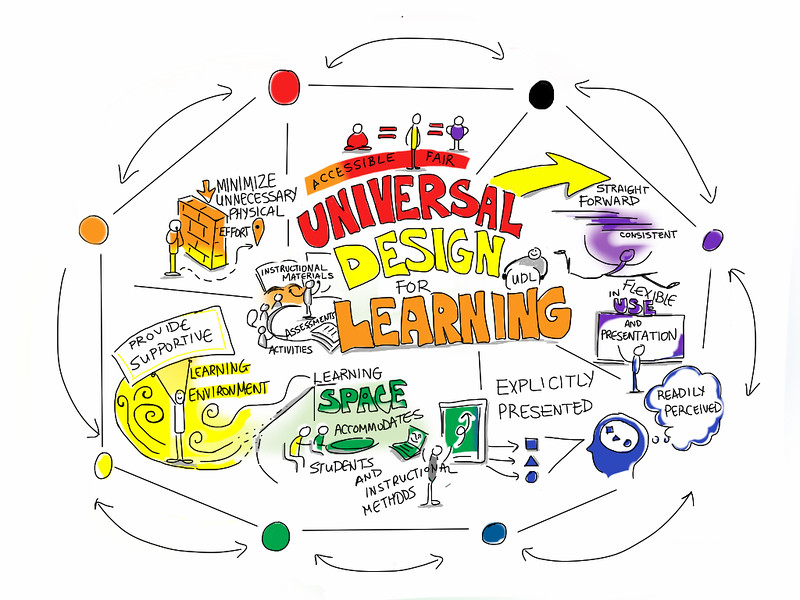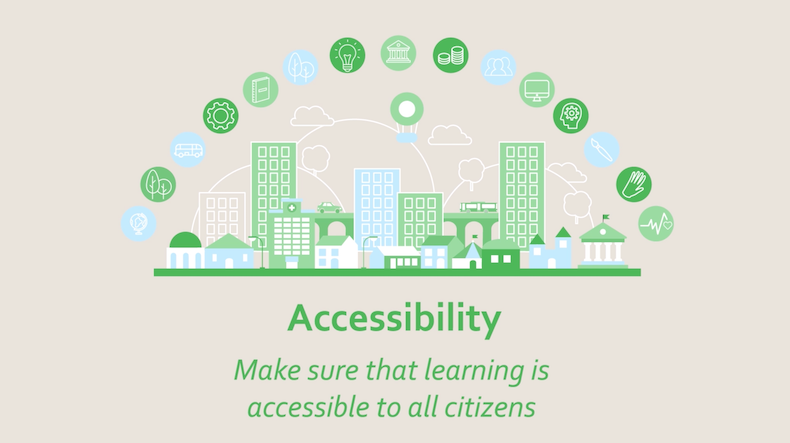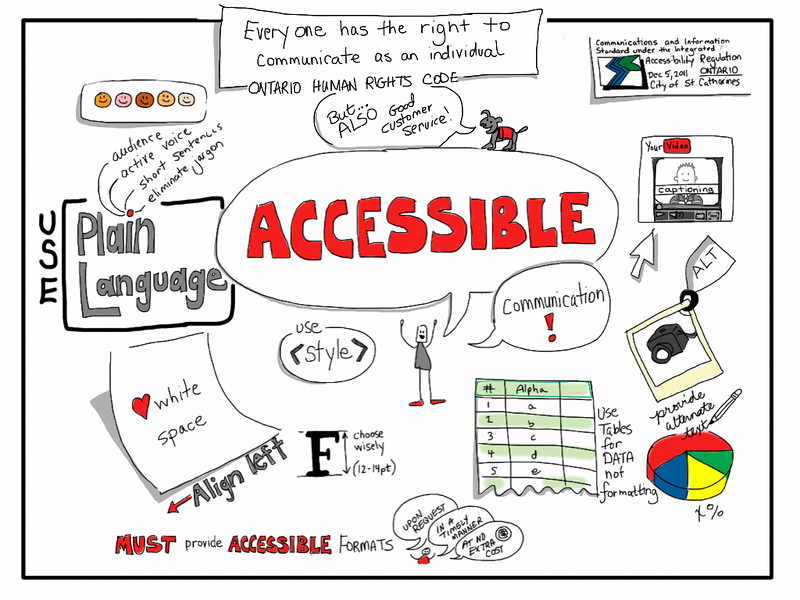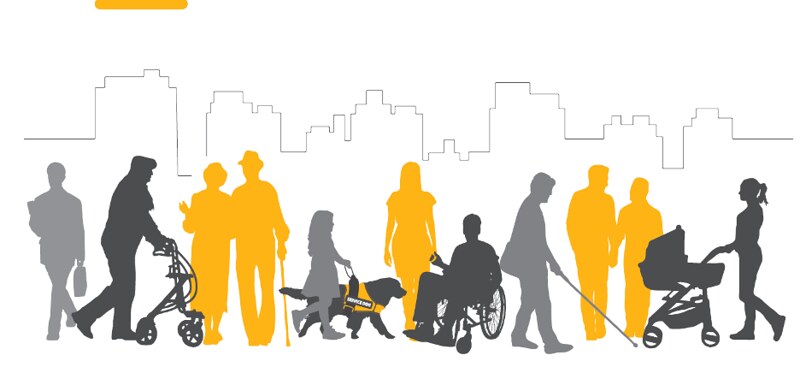In recent years, I have become increasingly interested in exploring Universal Design for Learning and its evolution to Inclusive Design. While I have always held a desire to make the courses, lessons and media that I create as accessible as possible, my newer disabilities from two car accidents have made me much more aware of accessibility issues in digital design. This has lead me to focusing some of my Master of Educational Technology work on exploring ableism, disability language and thinking, and universal design and inclusive design, so that I can both explore ways of challenging ableist thinking through my storytelling and improve the design of both my course materials and the digital storytelling content that my team and I create.
To listen to this article, click the red play arrow on the SoundCloud recording below:
Readings on Universal Design for Learning and Inclusive Design
To process my thoughts and understanding around Universal Design for Learning and Inclusive Design from readings and videos from:
- GDSE 584 Online
- Universal Design for Learning: Theory and Practice by Anne Meyer, David H. Rose, and David Gordon.
- What is Inclusive Design? from the Inclusive Design Research Centre
- The Inclusive Design Guide
- Inclusive Learning Design Handbook
… I invited colleagues, friends, and deep thinkers Lori Jones and Carrie Posner Sniderman to join me on an episode of the Encounters in EdTech Podcast to discuss and explore Universal Design for Learning and Inclusive Design. Tune in to that conversation in the video below or listen to the replay of the podcast on Fireside.
Exploring Universal Design and Inclusive Design in a Podcast Discussion
*Please stay tuned for the updated Closed Captioning, which will be available later this week. Current Closed Captioning is auto-generated and has errors that will be fixed.
My Reflections on Universal Design and Inclusive Design from the Readings and Discussion
Defining Universal Design for Learning
CAST defines “Universal Design for Learning as a framework to improve and optimise teaching and learning for all people based on scientific insights on how humans learn.”
For me Universal Design for Learning means creating with choice and accessibility in mind, so that students don’t have to ask for modifications; while at the same time creating a safe environment in which students know that they can come to the instructor should they need help or something different. This is important as every learner is different, meaning that we all have different needs, things we excel at and things we struggle with. Creating different options and pathways to learning makes sense, as it gives everyone the opportunity to excel.

This makes a tremendous amount of sense to me from my own history of experiences as a learner and with disabilities. In my young life with dyslexia, I learned that if I couldn’t achieve my goals one way (usually the way recommended in education), I just needed to find a different pathway to that goal and around whatever was creating the obstacle in my accomplishing that goal. Luckily I am stubborn and determined, so became very good at such problem solving.
Similarly as I have attended numerous medical programs to learn to manage my chronic pain, I have learned that what works for someone with a similar diagnoses to me, may not work for me, and what works for me, might not work for them. As a case in point, one fellow in my Masters similarly to me had post-concussion syndrome. In asking him how he was consuming the online reading, which were aggravating my concussion symptoms, I learned that he used screen readers, which were a helpful aid to him. Frustratingly for me, I struggle with screen readers, as they aggravate my symptoms and instead need natural voices. We did discover however that we mutually find mindfulness, breathing exercises, and meditation to be calming and to help manage our concussion symptoms.
The key here with Universal Design for Learning is remembering that there is no magic one size fits all. Rather the trick is in finding what works for you. As a teacher or designer, what this means is giving students options in learning and sharing what they’ve learned.

Framework for Universal Design for Learning
Universal Design for Learning is built around a framework of providing:
- multiple means of engagement
- multiple means of representation
- multiple means of action and expression
Basically what this means is giving students choices – choices in how they engage with the course material and one another, choices in how students consume the course materials, and choices in how students share what they’ve learned.
Multiple Means of Engagement in UDL
As a teacher multiple means of engagement might mean:
- discussion forums
- ‘office hours’
- scheduled group discussions
- options of different tools for processing the course materials, like mind mapping or discussing over a podcast
Multiple Means of Representation in UDL

What I am attempting to create in this post is an example of multiple means of representation of the information being shared. In this scenario, I am doing this by:
- providing my reflections and learnings in written form
- sharing audio readings of my writing
- sourcing images via CC and Public Domain licenses that illustrate the ideas I’ve written about
- adding Alt text descriptions to those images
- creating a podcast discussion of the ideas shared here
- making the podcast available in both video and audio formats
- creating written transcripts of the podcast, available for download or as closed captioning (it should be noted that the initial version of this transcript is auto-generated, but will be updated to fix errors in the autogenerated transcript
Multiple Means of Action and Expression in UDL
Give students options in how they present what they have learned, with parameters, to make sure that they meet the learning goals.
Take for instance, the assignment that I am addressing with this post, we (the students) were asked:
Based on your understanding of UDL, and of why it is important to provide learners with a range of options, please explain, describe, and/or demonstrate how digital technologies might be used to provide learners with a range of effective options for: engaging with learning goals, learning tasks and learning materials, representing learning materials and information to learners, and showing and demonstrating what has been learned.
With the above assignment, we were told that we could present this in any way of our choosing, provided we shared it in a digital format that was included in a website and preferably embedded into that website. To help guide us, we were given the ideas of a slide presentation, multimedia presentation, or audio recording, but were not limited by those ideas, being invited to present in any other digital format that works well for us provided it could be included on a webpage.
As is illustrated above, Universal Design for Learning is NOT dumbing things down for students. Rather it is about empowering the student to take ownership over their education and build expertise in learning.
Evolution of Inclusive Design
For me, in this initial investigation into Universal Design for Learning, I wanted to explore a little bit further to discover what if any differences there were between Universal Design for Learning and the newer term I’ve been encountering – Inclusive Design.
As defined by the Inclusive Design Research Centre, “Inclusive design is design that considers the full range of human diversity with respect to ability, language, culture, gender, age and other forms of human difference.”
They stress 3 dimensions of inclusive design:
- recognising diversity and uniqueness
- ensuring an inclusive process and tools, meaning including individuals who have a lived experience of the “extreme users” the designs are intended for, respecting the edict “nothing about us without us”
- encouraging the broader beneficial impact, beyond the intended user

While all of that sounds highly beneficial, I was skeptical that the term Inclusive Design was not simply tied to misunderstanding of Universal Design for Learning or perhaps a degree of ego, especially as the Inclusive Design Centre states that the “most important difference <with UDL> is that we do not need to design one-size-fits-all”, which in reading Universal Design for Learning: Theory and Practice and reviewing CAST’s materials is not the model for Universal Design for Learning either. In reading the “Why not use the term Universal Design?” section of What is Inclusive Design? from the Inclusive Design Research Centre and discussing with Lori Jones on the podcast, I am realising that this shift is not so much about Universal Design for Learning and Inclusive Design for Learning being at odds with one another in their approach to accessibility, but rather a move away from past misinterpretation of Universal Design for Learning as being one-size-fits-all model, based on the evolution of societal thinking towards disability and systemic ableism.
Given the above, the way I am interpreting Inclusive Design is the next step in the evolution of the aspects of Universal Design for Learning that focus on digital design, acknowledging the inclusion of all in our design thinking.
What’s Your Perspective / Interpretation?
As I stated above, both with Inclusive Design and the broader topic of Universal Design for Learning, this is how I am currently interpreting what I am learning about Universal Design for Learning and Inclusive Design from my readings and discussions. Do you have a different perspective or interpretation of Universal Design for Learning and Inclusive Design? If so, share it in the comments below.
Share Your Stories / Experiences with Universal Design for Learning and Inclusive Design
I would also love to hear about your stories / experiences with Universal Design for Learning and Inclusive Design in the comments below.

Leave a Reply